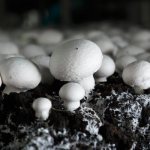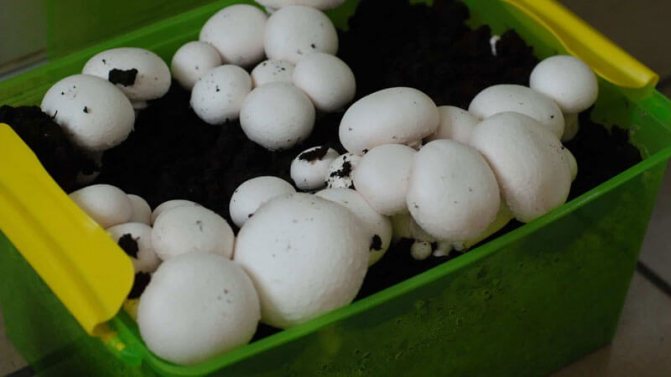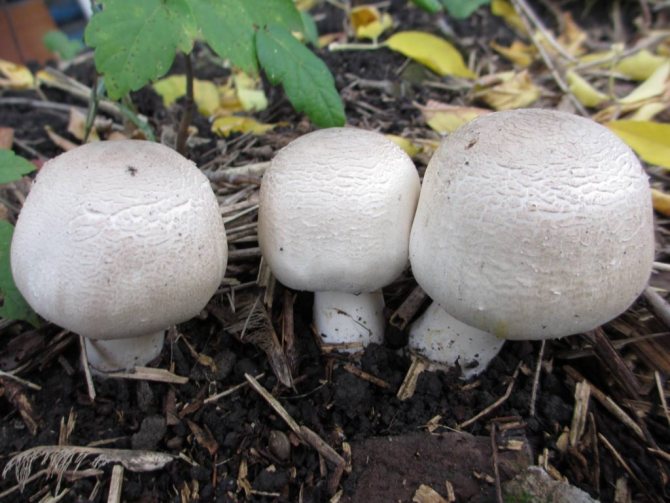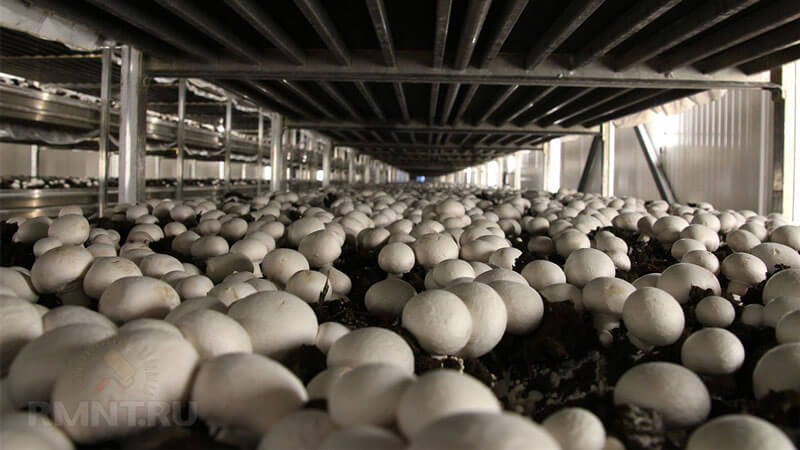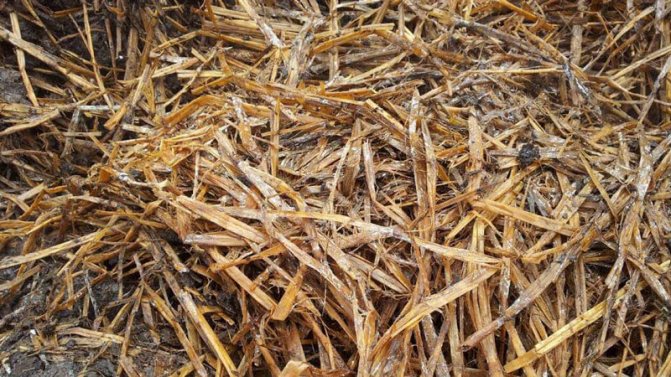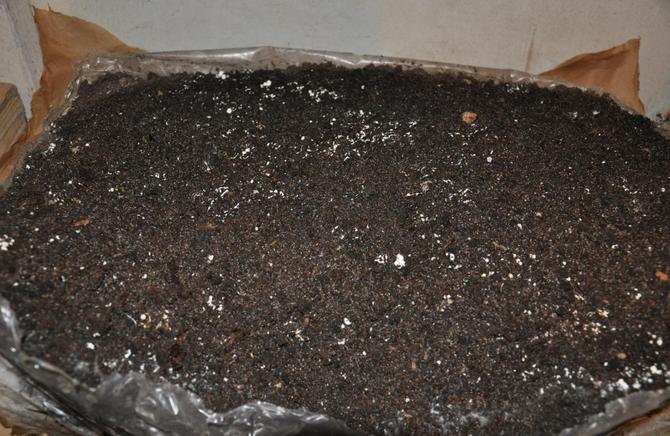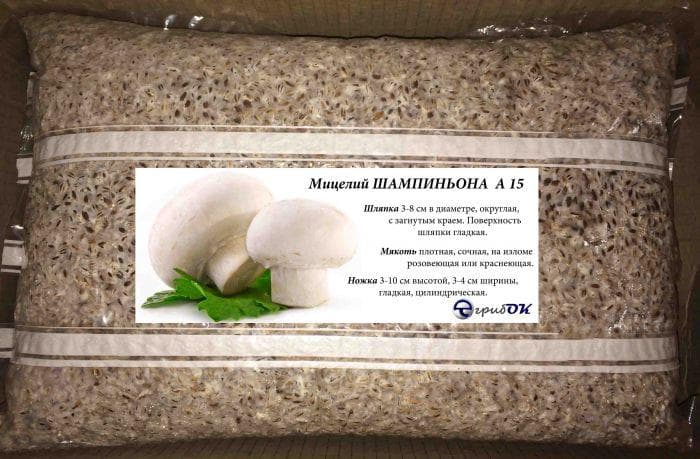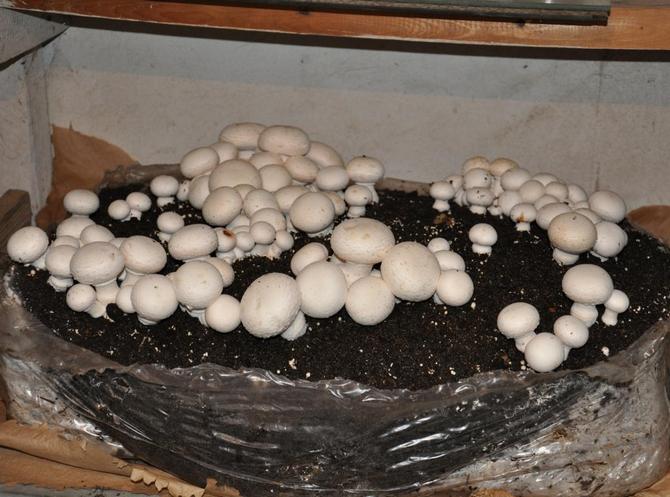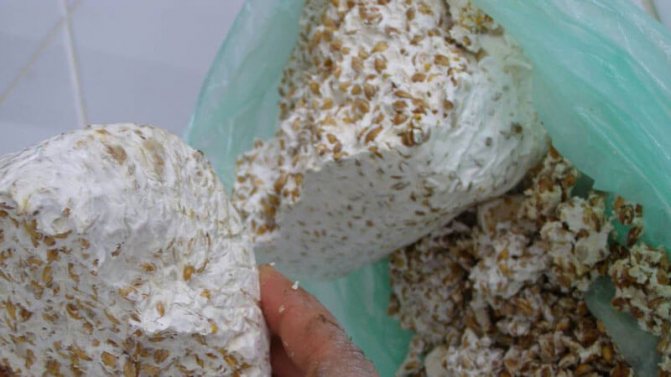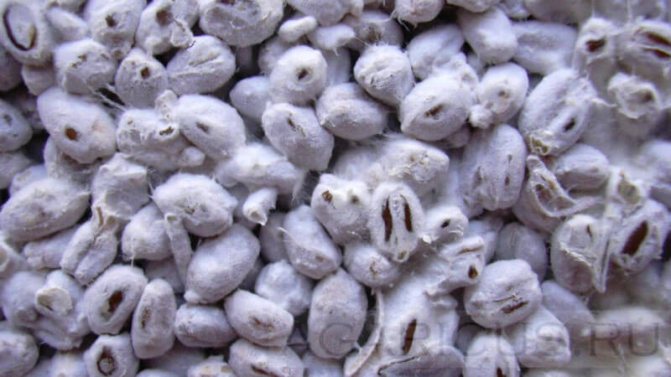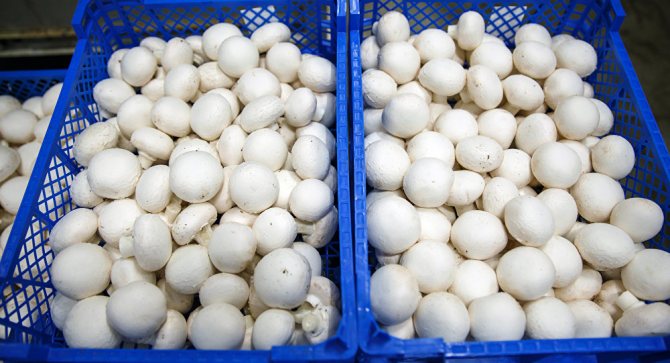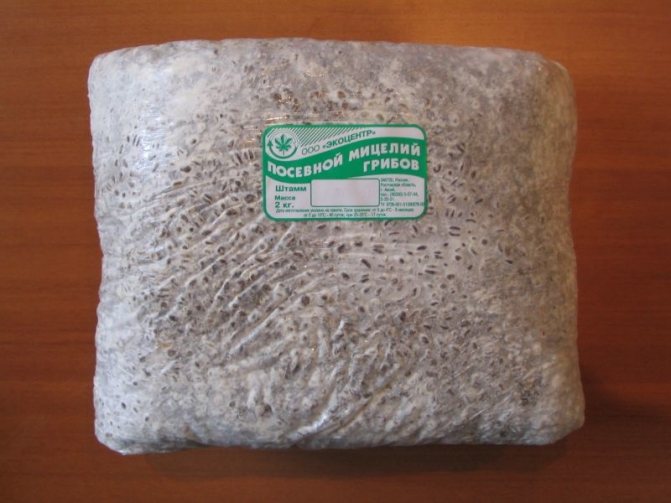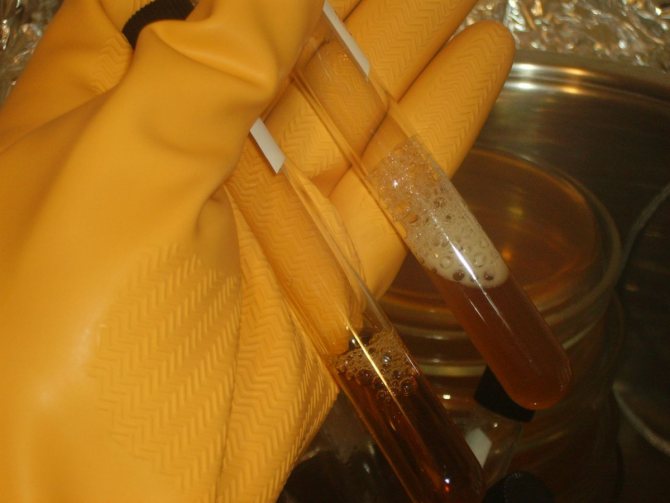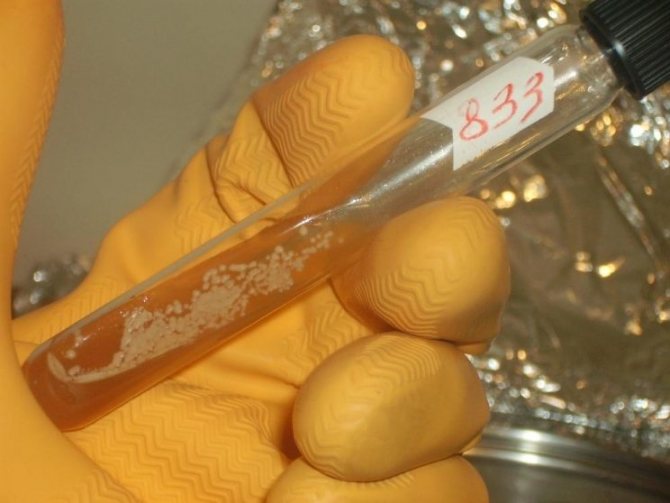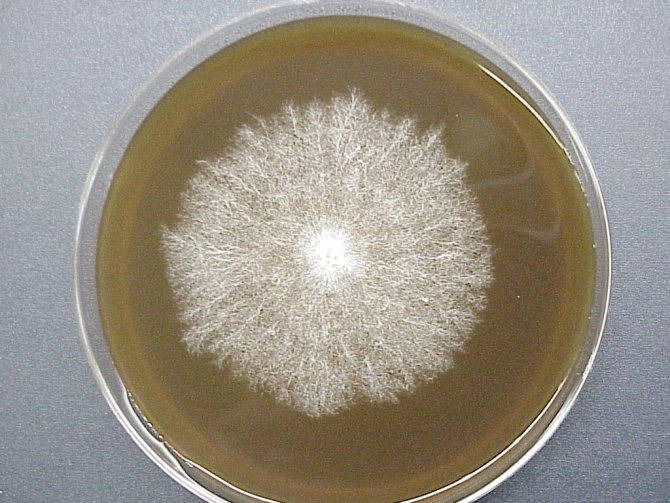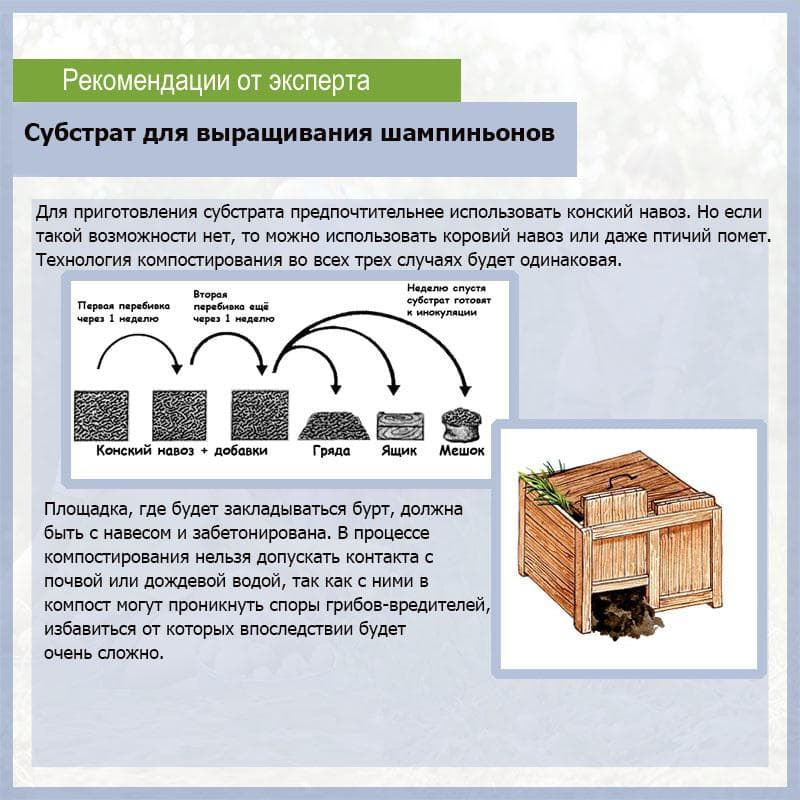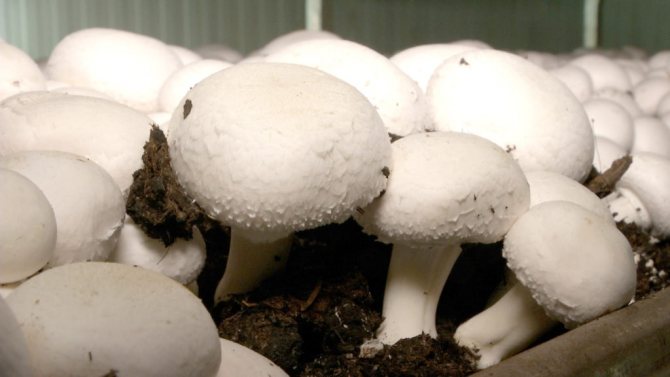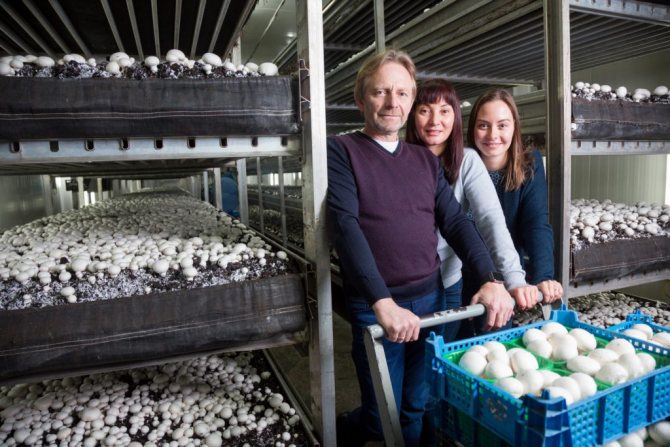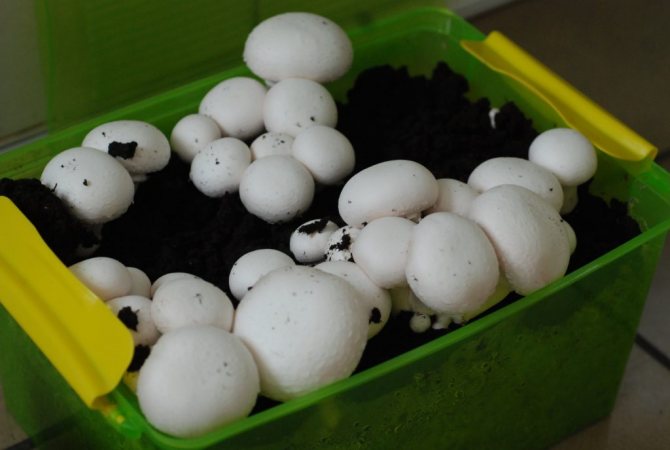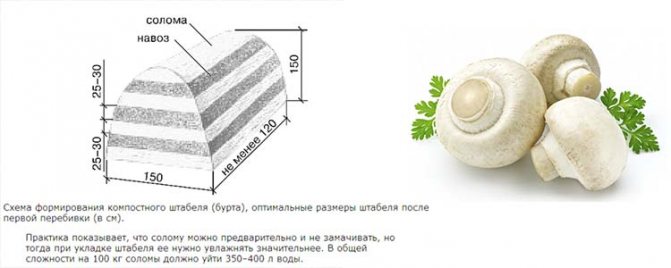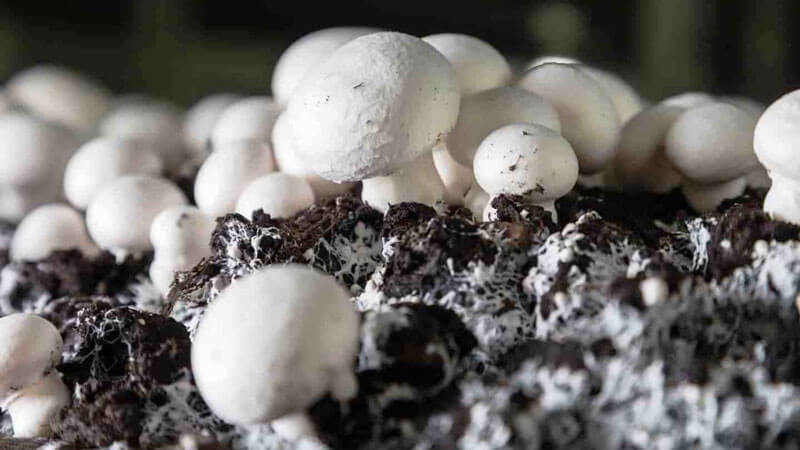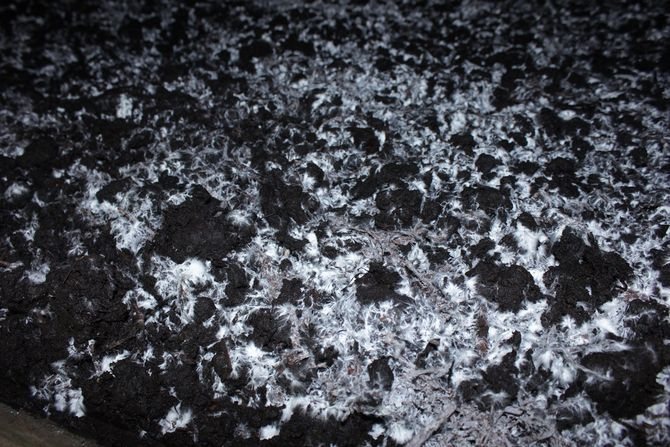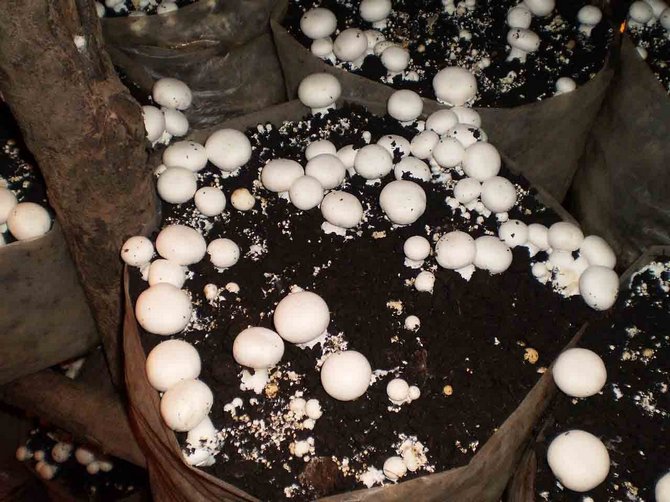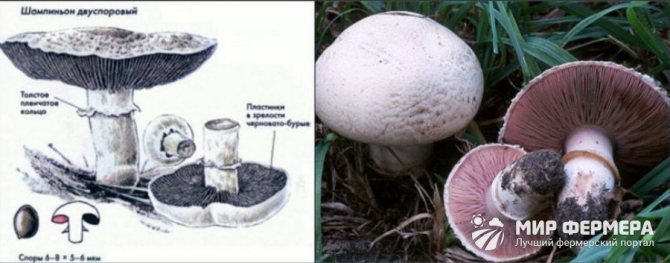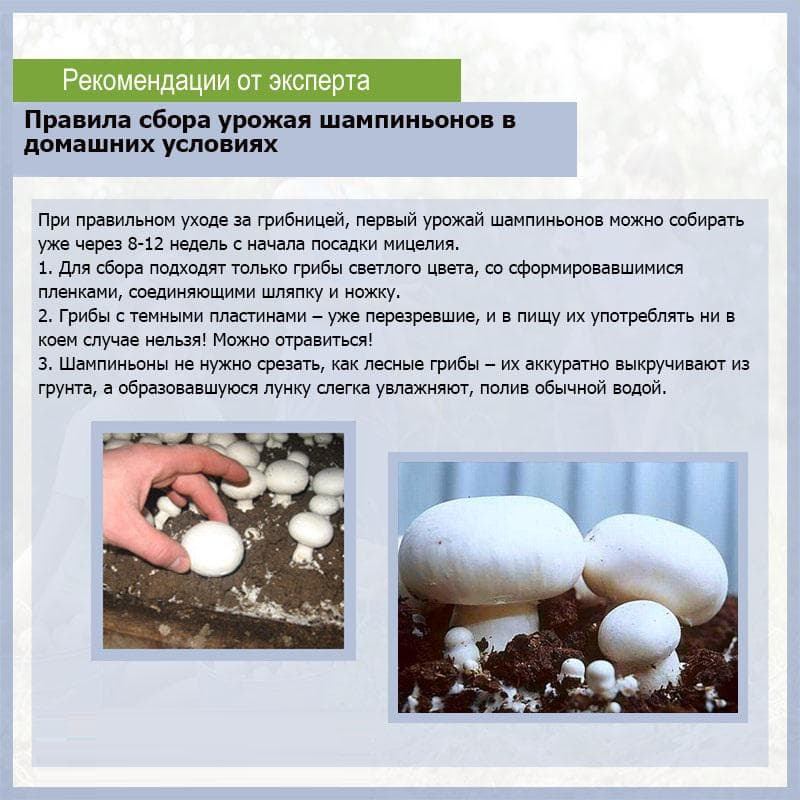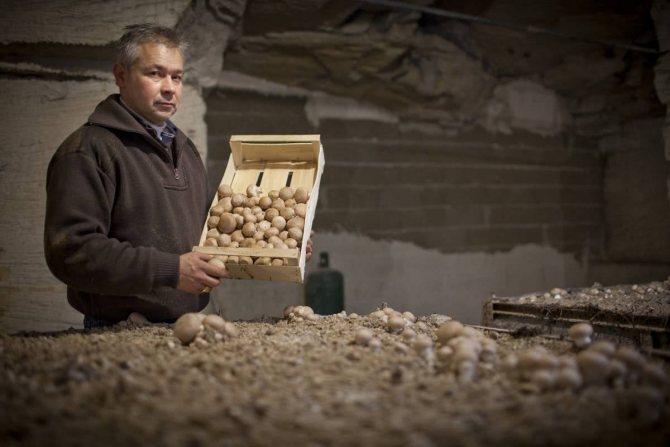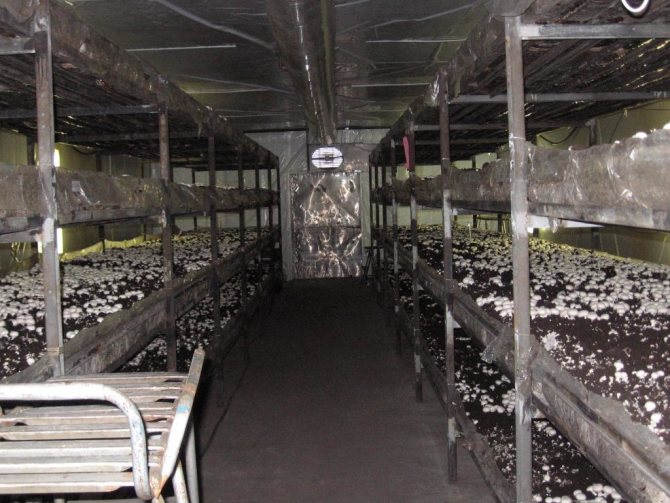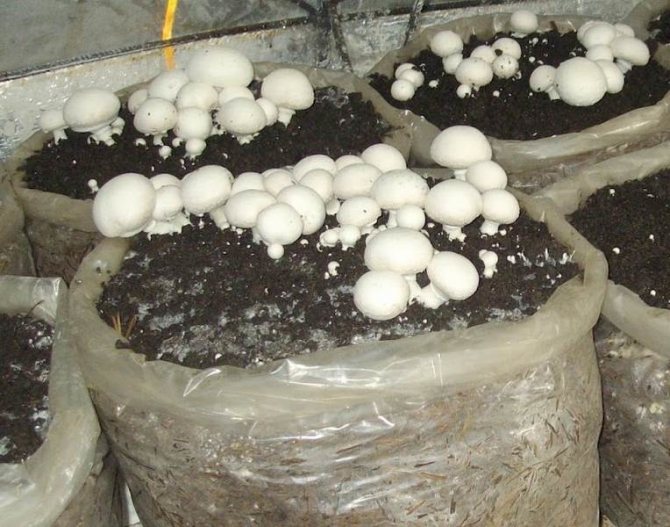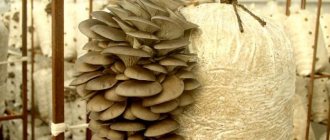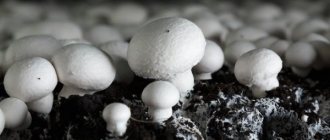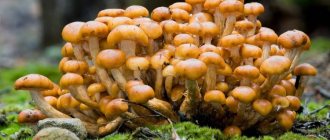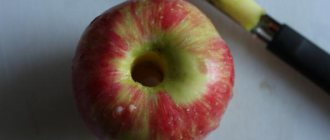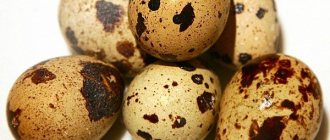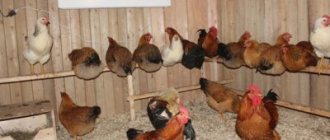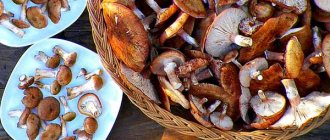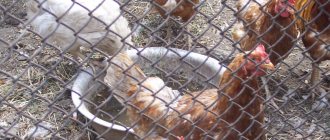Growing champignons at home is not a difficult task if you know what kind of room is needed for this, as well as what components to use to ensure stable and high-quality fruiting. Today, they use several popular methods of growing mushrooms on the territory of their home.
Selection and preparation of premises
Growing mushrooms does not require special knowledge and skills. The most optimal place for such a business is the basement or cellar of a private house. Mushrooms are not thermophilic and do not need constant lighting. If there is no basement, it is permissible to carry out the procedure in a greenhouse in the country or a shed.
The room must have concrete walls, cemented floors and good ventilation. Mesh material that covers ventilation openings will help prevent wrecking attacks. The walls and ceiling must be limestone.
What mycelium is needed?
The mycelium is also called mycelium. It is a vegetative body of fungi - a system of the finest branching filaments or hyphae.
The mycelium performs important functions, therefore, without it, the process of growing mushrooms will not take place:
- participates in sporulation and is responsible for the preservation of the resulting disputes;
- helps organisms to attach to nutrient substrates;
- adapts well to the environment;
- with the help of enzymes, it processes cellulose, obtaining from it substances available for growth and development.
The mycelium is an important organ responsible for the vegetative reproduction of organisms.
Buying a finished product
For growing mushrooms at home, it is recommended to use grain mycelium, since it is not only convenient to sow, but it does not need additional processing. When buying mycelium, pay attention to its appearance: the grains should be yellow with a slight orange tint.
It is not recommended to buy mycelium with dark spots - this is an indication that mold is present. The quality of the planting material is also determined by smell: there should be a distinct aroma of fresh mushrooms. If there is an ammoniacal odor, the product has not been stored properly and has been spoiled.
Be sure to pay attention to the manufacturer's company. It is advisable to choose mycelium from a reputable and major supplier. You shouldn't buy a lot of mycelium right away, it's better to take it for a sample first. If there are no problems with germination, the formation of myceliums will be good, then buy a large batch.
Self-cultivation of mycelium
Before planting mushrooms, many gardeners and gardeners grow mycelium on their own, referring to the fact that it will be possible to get a quality product this way. Mycelium, diluted at home, is compost and grain.
Preparation grain mycelium occurs according to the following scheme:
- Pour 10 kg of grains into a container, pour 15 liters of water.
- Put on low heat, bring to a boil and simmer for half an hour to an hour. The grains should not be soft, but they should be soft.
- Drain the water, dry the grain, and then pour the finished material into liter jars. Make holes in the lids and grains.
- Close the holes on the lids with cotton swabs. Place the cans in an autoclave with a pressure of 1.5 atm. for 30 minutes.
- Place the mycelium in the chilled grain, or rather in its holes.
- Put the jars in a thermostat with a temperature of 24 degrees, do not take it out until the mycelium completely occupies the entire nutrient medium.
For getting compost mycelium do the following procedures:
- Take 3-liter jars and fill 2/3 of them with mushroom substrate. Seal well.
- Roll up the jars with lids, making 3-centimeter holes in them, covering them with cotton swabs.
- Heat the compost to 24 degrees, place the mycelium in it.
- Sealing the holes in the lids will help prevent mycelium contamination.
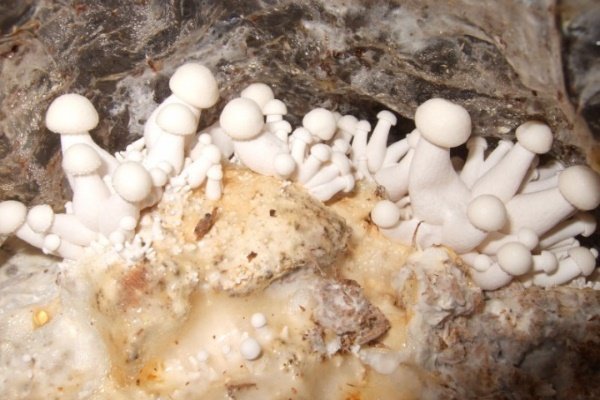
How to grow in containers
Champignons are also grown in containers, but this method is more practiced in foreign countries (Figure 7).
As mushroom blocks, special wooden containers are used, which are treated with antiseptics against mold. This method has several significant advantages. Firstly, the substrate is in separate containers, so it is easier to eliminate the negative consequences if it is affected by diseases or pests.
Secondly, such mushroom blocks are easier to maintain and disinfect, since the entire process can be made automatic.


Figure 7. Features of growing in containers
However, the use of containers for growing implies the purchase of additional equipment for servicing mushroom blocks, therefore it is economically unprofitable to use this method at home.
Preparing the substrate (compost): do it yourself
Mushrooms require conditions that are close to natural conditions, therefore, specially prepared compost is needed, the composition of which should be loose and nutritious.
To grow the maximum yield, prepare the substrate following the instructions. Since the strains or varieties of mushrooms are different, the preparation technology and the composition of the substrate may differ slightly. But there are general principles for preparing compost for growing mushrooms.
To prepare compost, combine the ingredients in the following proportions:
| First option | Second option |
|
|
It is permissible to replace horse manure with poultry or cow droppings, but in this case the yield will be lower.
Then follow the following scheme:
- The straw is soaked for 24 hours in warm water in a convenient container. Then they are stacked, mixing with layers of manure (there should be 6-8 of them). Moisten each layer with warm water.
- After 3-4 days, mix the compost well and add urea and superphosphate.
- After another 3-4 days, mix the compost again, gradually adding the remaining minerals. Add plaster of Paris for the last stirring.
On average, it takes 24-28 days to prepare compost. The fact that the substrate is ready is evidenced by the disappearance of the smell of ammonia and the acquisition of a light brown shade of manure. The finished substrate is moved to the basement and laid out in containers where mushrooms are planned to be grown.
Experienced mushroom growers recommend using compost that is less picky and more resistant to disturbances in growing conditions for the first planting. The yield with compost mycelium is not so rich, but it is much easier to get the first experience with it. Before planting the mycelium, carefully examine the substrate: it should be a little springy, not hard and not crumbly.
Consumer value
- 100 g of champignons is:
- 4.3 g protein;
- 1.0 g fat;
- 1.0 g carbohydrates;
- glycemic index 15;
- calorie content 27 kcal.
- Other beneficial substances:
- over 20 types of amino acids (tryptophan, methionine, cysteine, etc.);
- vitamins PP, D, E, B;
- nitrogenous substances (there are even more of them than in eggs and meat);
- trace elements.
With such a richness, champignons are deservedly equated with meat and seafood.
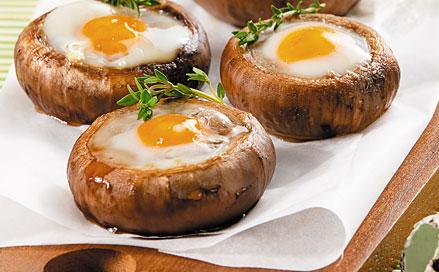

- Supporters of a healthy lifestyle appreciate champignons for the fact that they:
- strengthen the immune system (thanks to phosphorus, zinc, iron, potassium);
- low in calories;
- almost sugar-free (ideal for diabetics);
- relieve migraines thanks to riboflavin (vitamin B2) and thiamine;
- improve the condition of the skin (in terms of vitamin D content, they are comparable to high-quality country butter);
- relieve fatigue (due to the abundance of amino acids);
- indicated for diseases of the gastrointestinal tract and liver (in dried form);
- have excellent taste;
- easy to prepare;
- financially available.
Step by step instructions for beginners
There are several basic step-by-step rules that you need to know when planting and growing mushrooms at home. If done correctly, it will be possible to regularly obtain large yields of mushrooms.
Landing
After preparing the substrate and placing it in boxes or bags, it is planted with mycelium, which is deepened by 5 cm. A distance of 20 cm between the recesses is maintained. It is recommended to land in a checkerboard pattern. After planting, sprinkle the mycelium with soil.
If mushroom spores are planted, they are sown on the surface of the soil. After sowing, it is not required to sprinkle them with soil and moisten them. Cover the soil with a cloth and moisten it regularly. The mycelium grows within five days. At this time, the room maintains a humidity of 80-95% and a temperature of 22-27 degrees. After 12 days, the surface is covered with 1 part of limestone, 4 parts of soil and 5 parts of peat. The thickness of the layer should be at least 3 cm. After that, another 5 days should pass, the soil is periodically moistened. After another 5 days, the temperature is lowered to 13-16 degrees.
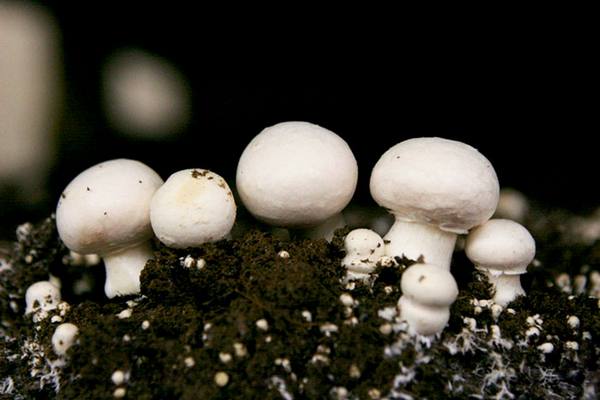

Growing and care
Although there is no need for constant care of mushrooms, it is required to pre-prepare the room and create special conditions in it:
- Growing equipment. Depends on the way the mushrooms are grown. Growing in bags is considered the best method. For this, special supports with hangers are useful, on which the bags with the substrate are suspended. The use of plastic equipment is recommended - it does not deform, does not lend itself to corrosion, and is much cheaper.
- Optimum temperature. Champignons do not require high temperatures, therefore they do not create greenhouse conditions. You just have to insulate the room, carry out thermal insulation, which helps to retain moisture. Heating devices must also be installed - the temperature should not fall below 13 degrees. The elevated temperature is set only at the initial stage. The use of infrared lamps is permitted for additional heating.
- Humidity level. Champignons love moisture, so the air in the room must be constantly humidified. It's simple: use sprays or special electronic humidifiers. The humidity level is not lower than 70-90%.
- Ventilation and lighting. Be sure to regularly ventilate the room. It is better to use hoods that deliver fresh air. But if you do not plan to grow in large volumes, it is permissible to manually ventilate the room. Several garden lamps are installed for lighting.
It is equally important to take care of fertilization. As the mycelium grows, it gradually appears on the surface, and after a couple of weeks it will be completely above the soil. To avoid drying out and destruction of the still fertile mycelium, a fertile substrate poured on top will help. Also, fertilizer is introduced into the soil, consisting of 9 parts of peat and 1 part of chalk. For 1 sq. m evenly scatter 40-50 g of the mixture.
Harvesting rules
3-4 months pass from the moment of sowing to the first harvest. Young mushrooms of medium size are collected, those that have a whole membrane that connects the stem and cap.As a seed, it is recommended to collect mushrooms with strongly opened caps - they lose their useful properties.
It is forbidden to pick mushrooms with a darkened light brown cap - they can cause intoxication of the body and lead to severe poisoning.
Champignons are not cut like wild mushrooms, but twisted. The hole remaining after collection is slightly sprinkled with compost. A mushroom will grow again in this place. Active fruiting of mushrooms lasts 8-14 weeks. During this time, the crop is harvested up to 7 times. Further, the yield decreases, therefore, the mycelium is removed, and the substrate is disposed of.
After the cessation of fruiting, the mycelium is removed and used as a recharge for the next generation. The remaining substrate is not reused, because it loses its fertile properties. From 1 sq. m collect up to 60 kg of mushrooms.
Care
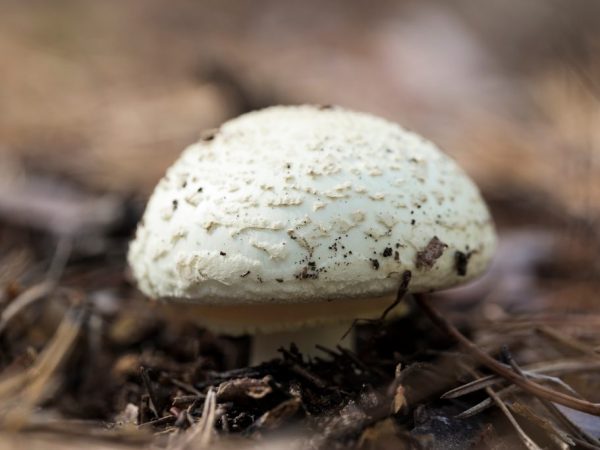

Up to seven layers of mushrooms can be removed from the garden
A week after the introduction of the casing layer, it is necessary to loosen it superficially.
To accelerate the germination of mushrooms, the room is closed for 1-2 days to minimize the flow of fresh air. Large amounts of carbon dioxide and high humidity levels stimulate mycelium growth.
If it is impossible to block the constant flow of air, the soil is covered with a film.
Champignons will bear fruit up to 7 times, the largest mushrooms appear in the first 3 stages. It is better to cut small mushrooms so that they do not pull off nutrients.
Types of mushroom cultivation
Mushrooms are grown in several ways: indoors or outdoors. Each method has its own specific requirements, the observance of which will allow you to get a large and high-quality harvest.
In the basement (in bags)
Experienced mushroom growers recommend using large plastic bags for growing mushrooms. This method is initially attractive in that it is possible to move the bags to any place.
How is the cultivation procedure carried out:
- A nutrient substrate is prepared, which consists of 70% horse manure and 25% compost mixture.
- Disinfect the substrate by heating up to 25 degrees.
- The mixture is laid out in bags 25-30 cm thick and the mycelium is planted.
- Leave on the rack for three days, after which 5-6 slots are made in the bag and left in the dark at a temperature of 18-20 degrees.
- After 2-3 weeks, mushrooms will begin to appear in the slots. The bags are transferred to a well-ventilated and constantly illuminated area.
- The mushrooms gain marketable weight in about 3-4 weeks.
- After harvesting, the bags are transferred back, after which the mushroom begins to grow again.
When fruiting, you need to monitor the moisture level - it should be about 70-95%. They also monitor the temperature of the substrate - 20-27 degrees.
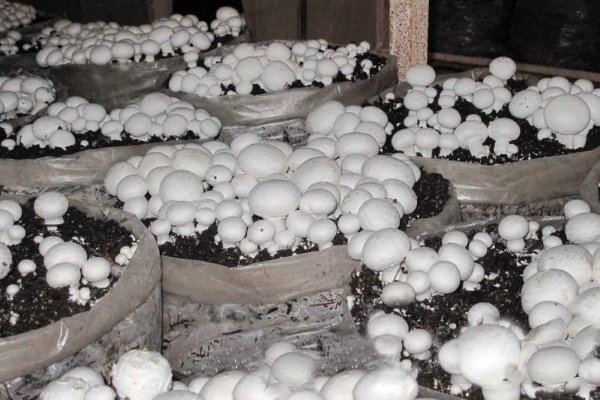

In the garden
For planting mushrooms, the site is prepared in the fall: the top layer of soil is removed - about 30 cm. The width of the beds should not be less than 1 meter. A distance of 55 cm is kept between the rows. A layer of expanded clay is poured at the bottom, which serves as a drainage layer. Its thickness should be 9 cm. Weeds are thrown over it, watered with mullein solution, sprinkled with soil.
Before laying the substrate on the beds, the soil is disinfected using a carbation solution. In the substrate, holes are made with a depth of at least 5 cm. The mushrooms are deepened into the hole by a few centimeters, sprinkled with a substrate. When using grain mycelium, it is scattered over the surface of the soil and tamped. Along the border of the bed, bends are made to drain excess moisture.
At a soil temperature of 25 degrees, the growth of mycelium occurs within 14 days. At a temperature of 30 degrees, the death of the mycelium is possible. For convenience, it is planted in a checkerboard pattern at a distance of 25 cm between the holes. After planting, the beds are mulched with straw, which helps to evaporate moisture.After rooting the mycelium, the straw is removed and covered with a covering layer using peat and chalk in a ratio of 9: 1.
On the balcony (at home on the shelves)
Growing on the balcony is one of the most convenient methods suitable for those who live in an apartment. No special physical and financial costs are required. This procedure is quite simple:
- Glazing and insulating the balcony.
- Build a small cabinet with shelving and drawers 20 cm high.
- Install a ventilation pipe with a valve in the cabinet, put a humidifier below to maintain the required humidity level.
- To prepare the substrate, mix 10 kg straw, 15 kg bird droppings, 8 kg alabaster. Increase the yield will allow the addition of superphosphate and urea - 200 g each. Everything is mixed in warm water. The boxes are insulated with moss.
- The substrate matures for 3 weeks. After that, add mycelium, preferably grain. It is evenly scattered on the surface of the substrate and the same layer 4-5 cm thick is poured on top. m of the substrate area make 350 g of mycelium.
- 10 days after germination of the mycelium, it is covered with a mixture of chalk and peat in a ratio of 1:10. The layer thickness should not exceed 4-5 cm.
- 5 days after backfilling the cover soil, the air temperature is lowered to 17 degrees. The surface is regularly moistened with water.
Fruiting occurs in 50-60 days, and the harvest continues throughout the year.
Container way
A simple way to grow mushrooms both in the apartment and in the house. It is permissible to place containers with a substrate in any convenient place. How is the procedure carried out:
- Prepare the container, be sure to take not only the container, but also the lid with the pallet.
- Disinfect the container and load the substrate.
- Sow mycelium, deepening it by 4-5 cm.
- Moisten the soil with mycelium.
Particular attention is paid to watering. Temperature is a secondary factor, but care must be taken to keep the reading below 30 degrees. This method is good because 3-4 containers will be enough for your own consumption, while minimal investment will be required.
Watch a video about growing mushrooms in a container at home:
Block way
Many mushroom growers today prefer to buy ready-made blocks for growing mushrooms from a pressed substrate. Large production facilities press manure, peat, sawdust and seed husks into briquettes. For mushroom production, it is not necessary to choose premises with large areas. Due to the complete preparation of the blocks, it is not necessary to plant mushroom mycelium in them, because it is already in them. One block weighs from 2.5 to 20 kg.
The blocks are laid horizontally on shelves and pallets, and holes are made on their surface. Burlap, film or paper that covers it will help prevent the block from drying out. After covering the block with mycelium, it is covered with a casing layer, and the airing is stopped. It is advisable to moisten the blocks by spraying. The first crop of mushrooms is harvested in 60-75 days.
What diseases and pests can you expect harm from?
Basic disinfection of the premises with the help of smoke bombs, spraying and liming will help to fight pests and diseases. But occasionally there are situations when mushrooms are exposed to various diseases and pests. The most common are:
| Name | The reasons | Control methods |
| Mushroom mite | A small yellow parasite that eats the legs of mushrooms. | Eliminate the problem by spraying mushrooms and compost with a 0.1% metaphos solution. |
| Mummies | A disease that occurs due to a lack of light. The caps of the mushrooms become dark gray, and the flesh is brown. | The infected mycelium is removed along with the substrate. |
| Mushroom midge | Fly larvae entering the compost with manure. Over time, the mycelium is affected, which is fraught with termination of fruiting and death. | The compost is treated with chlorophos 0.5%. |
| Rotting mushrooms | The development of the disease takes place with direct penetration of moisture into the already formed mycelium. This leads to instant infection of other fungi. | The spoiled myceliums are removed, those that remain are treated with a formalin solution with a concentration of 0.2%. |
| Mold | Wet brown spots are formed on the surface of the mushrooms, increasing in size. | Diseased mushrooms are removed, the substrate is sprinkled with superphosphate and table salt. |
Errors
Cultivating champignons at home can cause some problems.
| Problem | The reasons | What to do |
| Mycelium does not grow or grows slowly | Too wet compost | Reduce the number of waterings |
| The appearance of brown spots on mushrooms | Development of diseases of bacterial etiology | There is no way to save mycelium |
| Yellowish or white spots on the compost | The development of moldy fungi | Affected compost must be replaced with a new one |
| The appearance on the substrate of other types of fungi | Insufficient quality pre-treatment of the substrate | Remove third-party mushrooms |
Home business profitability
To determine the profitability of a mushroom growing business at home, you need to clearly determine what is needed for full development:
- lease of premises or construction of a new one;
- purchase of mycelium and the necessary equipment (racks, containers, etc.);
- purchase of funds for processing the premises;
- purchase of equipment for ventilation and air purification;
- sanitary examination of finished products.
Calculating costs is easy. The purchase of 5 tons of compost will cost 5 thousand rubles, mycelium - 2.5 thousand rubles. Heating the room - about 25.5 thousand rubles. Waste for employees is mandatory - up to 30 thousand rubles can be spent on wages for two people. In total, the cost part will be about 63 thousand rubles.
Calculating your profit is just as easy. Up to 1 ton of finished product is obtained from 5 tons of compost. The average cost of mushrooms is 200 rubles. From the sale of 1 ton, it will be possible to get 200 thousand rubles. The net profit will amount to 137 thousand rubles.
But these estimates do not include the investment in equipment, premises and costs that may arise during the growing process. Therefore, the mushroom picker can receive the payback of costs and the receipt of the first profit no earlier than in a year, observing all the requirements.
The following video will tell you about the nuances of growing mushrooms for business purposes:
It is not difficult to grow champignons on the territory of your house or apartment if you know all the subtleties. Compliance with all requirements and conditions will help to get a high-quality crop in large volumes. The use of some methods allows you to get a harvest not only for personal consumption, but also for sale.
0
Sales of products
Where to sell grown mushrooms, how to establish sales and get the maximum profit? These questions fall entirely on the shoulders of the entrepreneur.
One legal option is selling through food markets. True, it is more likely to be suitable for the implementation of small volumes, and it will take a lot of time.
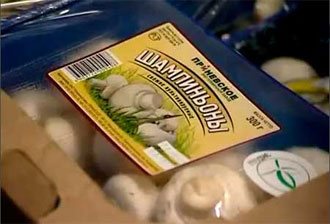

Another option may be to establish permanent relationships with shops, cafes, restaurants on the basis of concluded agreements. The delivery issue is usually resolved independently, although sometimes partners help their expensive suppliers (the product is highly valued in public catering).
Wholesale sales mean lower prices, but more substantial volumes, and less hassle. And you also save time to invest in new production runs.

